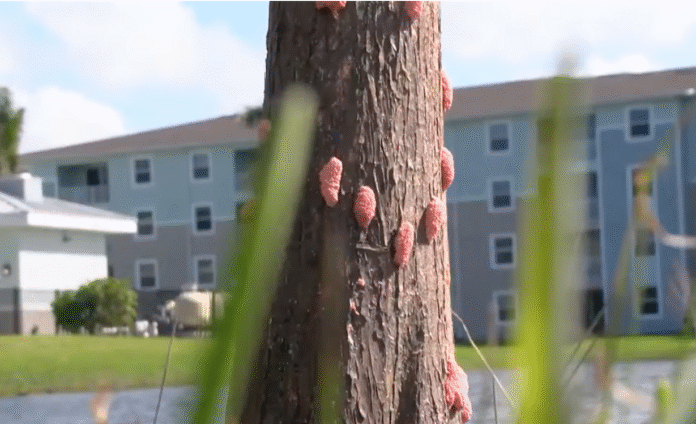- Invasive apple snails are spreading across Florida, laying bright pink egg masses that threaten local ecosystems, crops, and public health.
- Officials warn the eggs may carry harmful parasites and bacteria, advising residents to crush them with protective footwear and avoid direct contact.
- These fast-reproducing snails cause billions in damages, with infestations now reported in multiple U.S. states beyond Florida.
Something unsettling is appearing along Florida’s waterways and coastlines—vivid pink blobs clinging to plants, docks, seawalls, and even boats. While they may look harmless or even beautiful at first glance, officials are issuing urgent warnings: destroy them on sight. These bubblegum-colored clutches are anything but innocent.
They’re the egg masses of invasive apple snails—an aggressive, fast-breeding species native to South America. And they’re bad news for people, pets, and the environment.
Why Officials Are Telling Floridians to Crush the Eggs
According to the Florida Fish and Wildlife Conservation Commission (FWC), residents should avoid touching the eggs with bare hands. The gooey substance coating these clusters isn’t just sticky—it may harbor harmful parasites and bacteria. If smeared on skin and accidentally introduced to the mouth, nose, or eyes, it could lead to serious infections.
Instead of trying to remove them by hand, the FWC is urging the public to crush the eggs using sturdy shoes or protective gear. If left alone, they hatch into ravenous snails that destroy aquatic vegetation and edge out native species.
Even worse, if the pink blobs fall into the water, they’ll still hatch. So simply knocking them off surfaces won’t stop the invasion. The only way to help is to completely crush the masses.
Tiny Snails, Big Ecological Threat
Florida’s native apple snail is slow-growing and plays a key role in the ecosystem. It’s the primary food source for endangered birds like the snail kite and supports the health of wetlands by feeding on dead plant matter.
But invasive apple snails—especially species like the island apple snail and channeled apple snail—are something else entirely. These South American invaders breed rapidly and devour vast amounts of aquatic plants, leaving destruction in their wake. Their feeding habits can choke waterways, destabilize habitats, and make life harder for native fish, birds, and even humans.
In some areas, the snail invasion has already led to higher utility bills, degraded property values, and reduced recreational use of lakes and rivers. Fishing spots vanish, algae blooms spike, and once-vibrant tourist areas turn into weed-choked swamps.
The threat doesn’t stop at the waterline.
A Hidden Danger to Human Health
One species, the channeled apple snail, is capable of transmitting a dangerous parasite called rat lungworm. This parasite can cause a rare form of meningitis in humans, especially if someone eats raw or undercooked snails—or accidentally ingests snail-contaminated water or produce.
Doctors say infection can lead to headaches, neck stiffness, fever, vomiting, and in some cases, neurological complications. Although it’s still rare, experts warn that growing snail populations raise the risk.
And since many of these snails were first introduced to Florida through the pet trade, officials are now pleading with aquarium owners not to release any unwanted snails or aquatic pets into the wild.
Florida’s Battlefront: Snails Take Over Lakes and Rivers
The problem is no longer isolated. Since 2013, invasive apple snails have been confirmed in 38 of Florida’s 67 counties, spreading into 29 watersheds. Infestations are widespread in central and southern Florida, with major outbreaks in places like Lake Okeechobee, the St. Johns River, and Everglades National Park.
Beyond Florida, states like Texas, Louisiana, Georgia, and even California are now facing similar problems. In rice fields and agricultural zones, the snails are becoming a nightmare—eating young crops and clogging irrigation systems.
It’s a creeping crisis that no one seems able to stop.
An Explosive Reproduction Rate
The biggest problem? These snails don’t waste time.
While native apple snails lay smaller clutches of around 20–80 eggs, invasive snails take reproduction to the extreme. The island apple snail can lay up to 2,000 tiny eggs at once, packed tightly into a single layered clutch. The channeled apple snail isn’t far behind, releasing up to 800 eggs per batch.
Worse, the young hatch in just a few weeks. Once mature—often in just two to three months—they start laying eggs of their own. The cycle repeats endlessly, overwhelming natural checks and balances.
Add to that their size—some grow up to six inches long—and it’s no surprise the FWC has ranked the apple snail among the world’s worst invasive species.
More Than an Eyesore—A Multi-Billion-Dollar Problem
A 2021 study revealed the staggering financial burden these snails create. Cleanup, ecological damage, lost tourism, and agricultural harm have cost North America more than $26 billion each year since 2010. On a global scale, invasive species have drained an estimated $1.288 trillion from the economy over the past five decades.
This isn’t just Florida’s problem. It’s everyone’s.
How to Spot—and Stop—Them
If you’re wondering whether that snail in your backyard pond is part of the problem, identification isn’t easy. Many species look alike, but there are a few clues:
- Native Florida apple snails are about two to three inches long with pale salmon-colored eggs that turn white before hatching.
- Invasive species often appear more colorful, with shades ranging from yellow-orange to copper and even green, thanks to their origins in aquarium breeding.
- Their eggs are brighter, smaller, and more numerous, often clinging to hard surfaces above the waterline in bright pink clumps several inches long.
If you see these clusters, act fast—but don’t touch them with your bare hands. Crush them thoroughly and report the location to local wildlife officials if possible.




